Texas is well-known for its diverse topography and is referred to as “The Lone Star State” to honor its fight for independence from Mexico. You can discover woods, swamps, mountains, deserts, plateaus, and grasslands in various parts of the state. Texas is home to a sizable number of animals from numerous species. But does this group include deer? Are there deer in Texas? Luckily for Texas residents, this wide range of wildlife includes deer, and several types of deer inhabit the Lone Star State’s lands.
Deer are recognizable creatures prized for their delicious, red flesh. These hoofed ruminant mammals come in varieties, including roe deer, reindeer, and moose. Deer have a significant role in the folklore of many western civilizations; most notably, they pull Santa Claus’ sleigh. But what types of deer are found in Texas? Below, we will discover the 7 types of deer you can find in the Lone Star State, where they live, and more interesting facts.
Deer in Texas
Deer hunting is a popular winter and fall activity for many people, and Texas is home to millions of deer of various species. White-tailed deer and mule deer are the two native deer species to Texas’s vast and diverse countryside. Several species of deer have been imported into Texas for hunting, in addition to the two native varieties of deer that are native to the state.
7 Types of Deer in Texas
1. White-tailed Deer
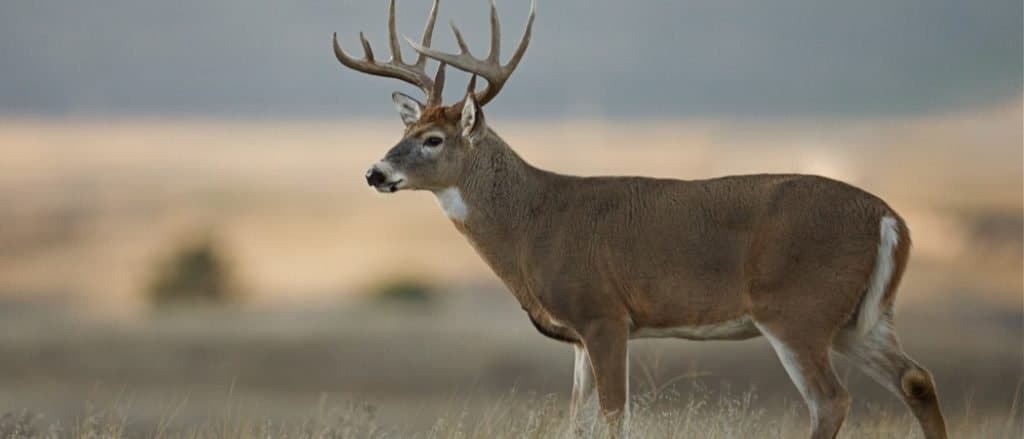
Around 5.3 million white-tailed deer inhabit 252 of 254 counties in Texas.
©Tom Reichner/Shutterstock.com
Texas has a lot of space for deer because it is the largest of the lower 48 states. The number of white-tailed deer in Texas is steadily increasing, mainly confined to the Edwards Plateau and so-called Hill Country regions. White-tailed deer are versatile creatures that live in woods, prairies, coastal areas, and grasslands.
Appearance
The white-tailed deer, which has an appropriately prominent white underside when reared, is one of North America’s (and Texas’) most recognizable big game animals. The white-tailed deer’s coat is a reddish-brown hue during the spring and summer. However, it changes to a grayish-brown color in the fall and winter. Antlers are only found on male white-tailed deer, and just one in 10,000 females have them. The majority of antler-bearing females are infertile due to malfunctioning ovaries.
Habitat
The majority of the middle and western regions of the state are where the Texas white-tail may be frequently found. They often live in fields and meadows where they take advantage of trees with large leaves for shade during the hot summer months. They are forced to remain in the forests throughout the winter because there are larger, more shady trees that can offer protection from the severe weather.
Although the white-tailed deer are native to North, South, and Central America, they have also been imported to New Zealand and several European nations, including Germany, the Czech Republic, France, Romania, Finland, and Serbia.
Population
In Texas, 252 of the 254 counties are home to an estimated 5.3 million white-tailed deer, distributed everywhere, from metropolitan parks to the most rural rangelands.
2. Mule Deer
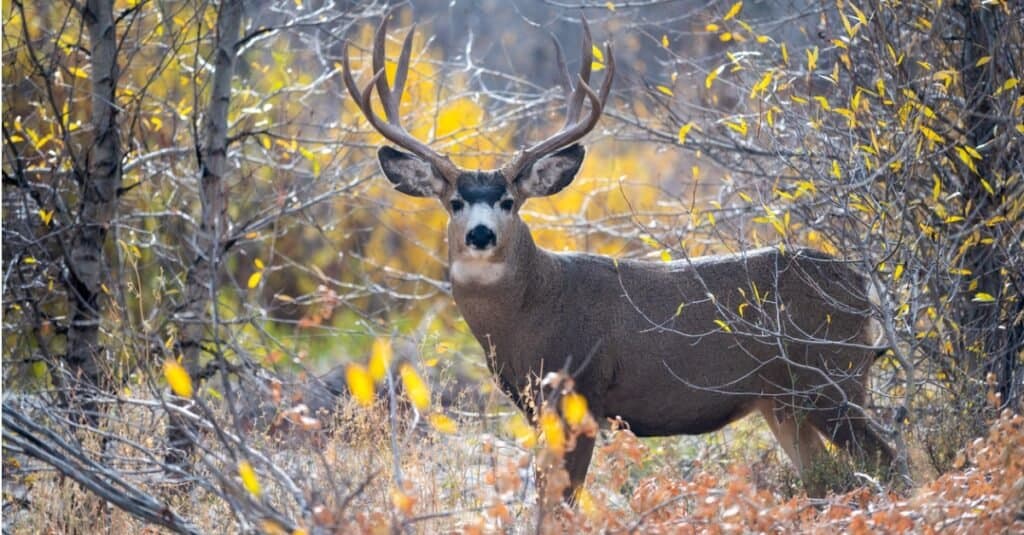
Texas has no migratory mule deer; these species are endemic to the state.
©iStock.com/EEI_Tony
The mule deer is a New World Deer species native to Western North America. These deer were given their name because their ears resemble those of mules.
Appearance
The mule deer is named after its large ears which resemble those of a mule (donkey) and is found in West Texas. The mule deer’s tails are black at the tip rather than having a white underside. Mule deer bucks standing alertly have an average ear-tip to ear-tip spread of 21 inches.
Habitat
Texas has no migratory mule deer; these species are endemic to the state, along with white-tailed deer. In the Trans-Pecos, the normal mule deer home range is 2 to 4 square miles. According to research done in Brewster County, white-tailed does have an average home range of 1,341 acres, whereas bucks have an average home range of 1,956 acres. In addition to being widely distributed over North America, mule deer can also be found in places like Argentina, Hawaii, Idaho, Wyoming, and the valley of the Rocky Mountains.
Population
In Texas, the number of mule deer varies from about 150,000 in dry seasons to about 250,000 in rainy ones. The Trans-Pecos region is home to about 80 to 85 percent of the herd, with the remaining 15 to 20 percent living in the Panhandle and the western Edwards Plateau.
3. Axis Deer
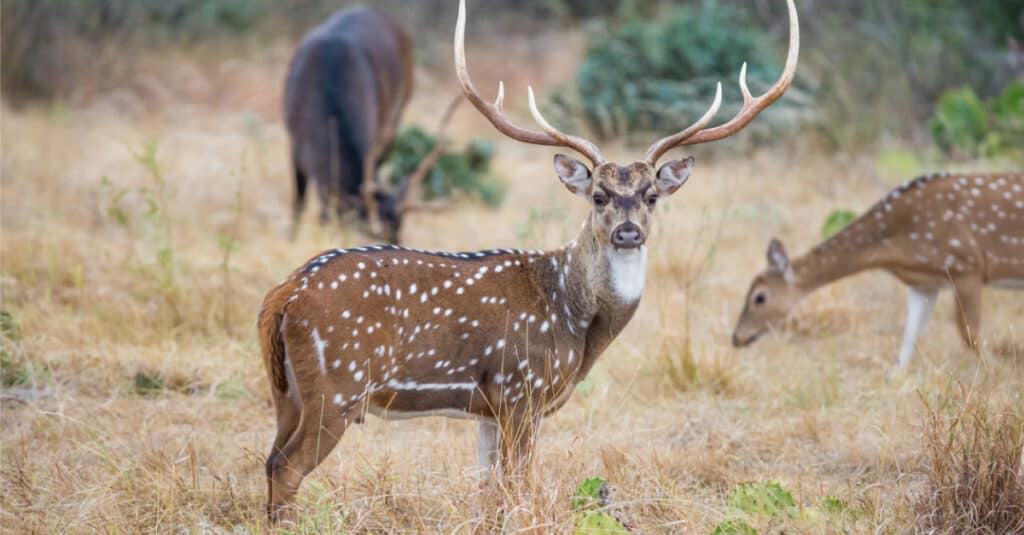
The axis deer’s dorsal side is rufous in hue and covered in sporadic white patches.
©iStock.com/GizmoPhoto
Axis deer are known by a variety of names, including “spotted deer” and “chital deer,” but they are most frequently referred to as “Chital.”
Appearance
The axis deer’s dorsal side is rufous in hue and covered in sporadic white patches. They have a white belly, tail, rump, throat, ears, and insides of legs.
Habitat
The axis deer prefers to live in semi-evergreen and deciduous forests and open grasslands. Although this species of deer is native to South Asia and the Indian subcontinent, it has existed in Texas since the early 1930s, when it was introduced as a game species to the state’s southern regions.
Population
According to statistics from the Texas Invasive Species Institute, there are currently more than 6,000 axis deer population in the state. That herd negatively affects riparian habitat, native fauna, and agricultural production.
4. Elk

Elk can be seen in Native American petroglyphs in western Texas.
©Cody Linde/Shutterstock.com
The largest members of the deer family and one of the biggest land mammals in North America and northeast Asia are elks, also referred to as “Wapitis.”
Appearance
Elk have a tiny tail, several noticeable buff rump patches, and a reddish tinge to their coat. The bulls are considerably heavier and taller than the cows.
Habitat
Elk can be seen in Native American petroglyphs in western Texas, and travelers have reported seeing vast herds of elk as far back as the 1600s in the Panhandle, North Texas, Trans Pecos, Edwards Plateau, South Texas, and even the Pineywoods regions. Elk are present in Northeast Texas, according to recent archeological excavations.
Population
In 1995, 330 elk were thought to be roaming free in the Trans-Pecos; in 2014, that number was closer to 3,500. Others are maintained in deer-proof pastures on a few scattered ranches throughout the state.
5. Fallow Deer
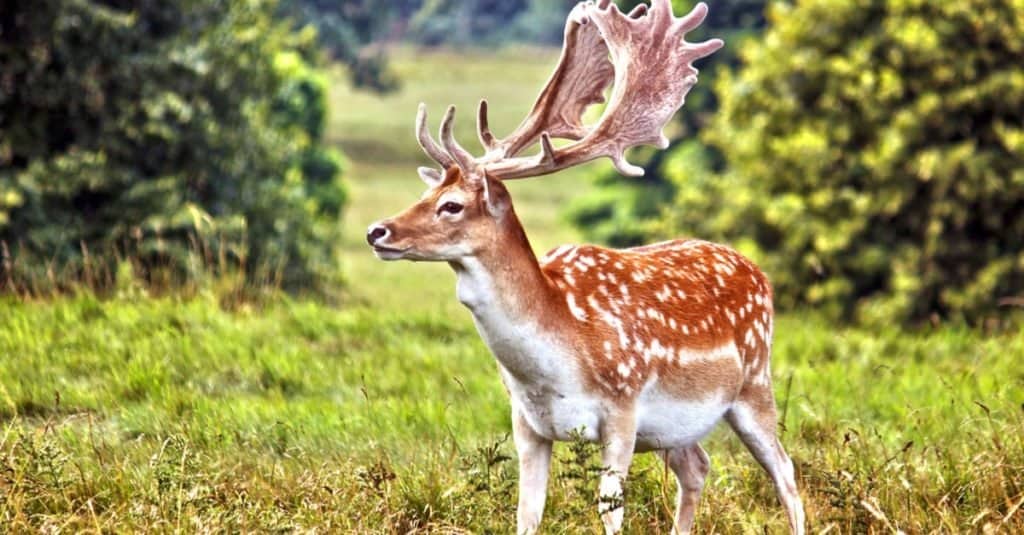
Texas is home to over 10,000 fallow deer.
©Neil Clarke/Shutterstock.com
Another exotic and invasive deer species, the fallow deer, is a small deer endemic to Eurasia, which now competes with the natives and threatens to disrupt ecological systems.
Appearance
An adult male fallow deer can reach 200 pounds and is around 32 to 40 inches tall at the shoulder. The antlers of fallow deer are extensively palmated, with multiple little tines and one enormous heal-tine emerging from the back of the palm.
Habitat
93 Texas counties have received the fallow deer, mostly in the Edwards Plateau area. Although fallow deer can be found in South Texas, the Texas Hill Country, and the Edwards Plateau, most fallow deer hunting takes place near Kerrville.
Population
Currently, Texas is home to over 10,000 fallow deer, roughly one-third of whom are not confined. Fallow deer are the most commonly kept deer in the world and are indigenous to the Mediterranean region of Europe and Asia Minor.
6. Sika Deer

Sika deer are typically compact, tiny to medium-sized creatures with short, wedge-shaped heads.
©iStock.com/Elena Tcykina
In Texas, there are no hunting limits on the Sika deer during specific seasons, making it an ideal trophy from August to March.
Appearance
Sika deer are typically compact, tiny to medium-sized creatures with short, wedge-shaped heads. The hue of sika deer can vary from mahogany to black.
Habitat
In central and southern Texas, Sika deer have been introduced to at least 77 counties, with free-ranging groups known from 12 among these counties. Historically, Sika deer are indigenous to southern Siberia, the neighboring Japanese island of Hokkaido, and China. Due to habitat degradation, Sika deer have quickly vanished from most of their natural range.
Population
Sika deer were introduced to the country for the first time in 1916. Over 5,500 of them were thought to be living in the state in 1994, with nearly half free-ranging.
7. Barasingha Deer
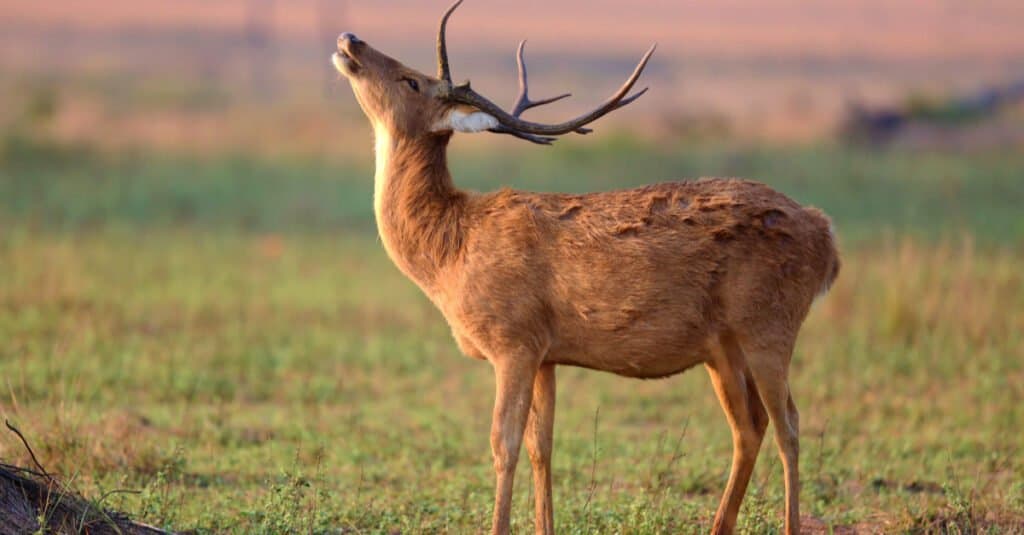
The barasingha deer has a dark dorsal line and a golden brown summer coat.
©PhotocechCZ/Shutterstock.com
Barasingha was introduced to Texas for sport hunting almost a century ago, and it is now required by national law that 10% of the trophy fees for hunting be sent to India to preserve the species in its natural habitat.
Appearance
The barasingha deer has a dark dorsal line and a golden brown summer coat. The males develop a noticeable neck ruff throughout the winter, and their coarser dull grayish-brown coat has lighter underparts. They weigh 350 to 400 pounds and reach 44 to 46 inches tall at the shoulder, with females significantly smaller.
Habitat
This swamp deer adores the water. Large river floodplains with reed beds and tall grassland are this species’ preferred habitats. However, mangroves and dry deciduous woods are among the forested areas where barasinghas are frequently spotted.
Population
There are few barasingha deer in Texas, considering that the species is marked “vulnerable” or decreasing. Currently, there are only around 800 in the world.
Bonus: Why Do Deer Sleep in My Yard?

Deer will make a home base in your yard if the food is plentiful and it is safe.
©Ginger Livingston Sanders/Shutterstock.com
As animals are forced out of their habitats by human development, you may have noticed that deer sightings are becoming more frequent. If you live in an area with some wooded areas in between houses you may be surprised to learn that deer don’t roam very far and can be content to live in 100 yards of area if it is safe from predators and has plenty of food and water. Often, a residential area fits the bill just perfectly.
Deer tend to sleep during the day – so you may be surprised to look out your window to find a deer (or several) resting under a thicket of shrubs in your own backyard. Creatures of habit like deer may decide to call your home theirs and remain for the rest of their life! If you have a garden they will help themselves to it – as well as any flowers and shrubs you may have planted. If there are multiple deer they could destroy all of it and become unwanted pests.
If you have plenty of space and choose to coexist with these lovely animals that is fine – but be aware that deer carry ticks that transmit Lyme Disease. This confusing disease remains with infected people for life and causes a range of symptoms that make it difficult to diagnose. Lyme Disease causes aching muscles, joint pains, constant fatigue, fever, and headaches. Because of exploding deer populations and more deer encroaching on urban spaces – as many as one million people per year are diagnosed.
There are ways to deter deer from taking residence in your yard – and if you have children or dogs it would be a good idea to keep them out. You can grow plants they don’t like or use commercial deer repellant. If your yard is wooded and you don’t use it much you could just relax and enjoy providing them a safe haven.
The photo featured at the top of this post is © Ginger Livingston Sanders/Shutterstock.com
Thank you for reading! Have some feedback for us? Contact the AZ Animals editorial team.






